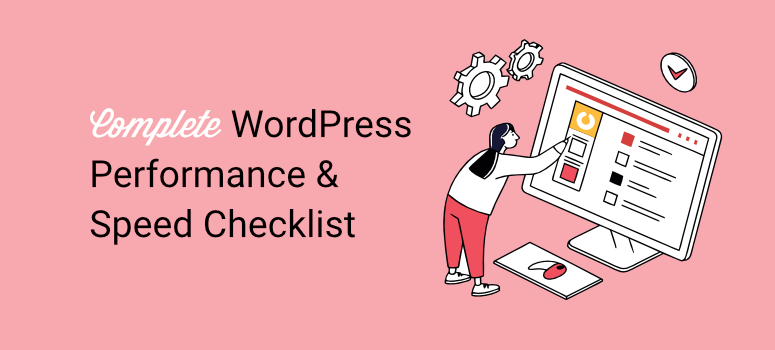Last month a customer called me in a panic.
Their online store, which I helped build, loaded so slowly that customers abandoned their carts before checking out. We did a quick test – 12 seconds on the phone. This is business suicide in 2025.
Within two hours of following a simple optimization checklist, we reduced their site to 2.1 seconds. As a result, their sales increased significantly after 2 weeks.
Look, WordPress performance isn’t rocket science.
Most websites are slow due to some fixable issues. These problems include poor hosting, bloated themes, unoptimized images, and lack of caching.
What if you now systematically fix these problems? And your website changes.
This WordPress speed and performance checklist will walk you through all the optimizations that actually make a difference.
We’ll start with the quick wins that only take a few minutes to implement. Then move on to advanced techniques for additional speed gains.
What you will achieve:
- Loading times worldwide under 3 seconds
- Core Web Vitals in the green
- Better search rankings and user experience
- Higher conversions and lower bounce rates
Understanding WordPress Performance vs. Speed
Most people think that WordPress optimization is all about how quickly pages load. But the performance is greater.
Let me explain. WordPress speed is how quickly your pages load for visitors WordPress performance is a comprehensive user experience, including speed, responsiveness and stability
Performance benchmarks 2025
Your WordPress site should achieve these goals:
- Largest Contentful Paint (LCP): Under 2.5 seconds – How long does it take your main content to load?
- Interaction with Next Paint (INP): Under 200ms – How quickly your website responds when users click buttons
- Cumulative Layout Shift (CLS): Below 0.1 – Prevents annoying page jumps when loading
- Overall PageSpeed Score: 85+ mobile, 90+ desktop – Google’s rating of your website speed
- Loading time: Less than 3 seconds worldwide – total time it takes for your page to fully load anywhere
Understanding the Basics (5 minutes)
Before we start optimizing your WordPress site with this checklist, let’s understand what we’re actually fixing. This only takes 5 minutes but will prevent you from feeling lost during the process.
Remember that speed optimization can be overwhelming if you don’t know why you’re doing each step. But once you understand the basics, everything falls into place.
To make it easier to understand, I have also included the reason for the corrections in the checklist. This way you can track everything more efficiently.
You can also use the table of contents below to quickly go through the checklist and jump to the section you want to read.
Let’s get started!
Why website speed matters for your business
Here’s the truth about slow websites that most beginners don’t realize:
☐ Understand that 1 second delay means 7% fewer sales
This is not just a random statistic. Amazon has discovered that it is losing $1.6 billion annually for every second of delay. What this means for your business is that you are losing real money.
This is because people who click on your website expect instant results. If your page takes 4 to 5 seconds to load, they assume something is broken.
And just like that, they click the back button and buy from your competitor instead.
Even if you don’t sell products directly, slow websites hurt you. Fewer people read your content, sign up for your newsletter, or contact you for services.
☐ Be aware that Google will rank faster websites higher
As you know, Google’s job is to show people the best results. Since 2010, they have taken website speed into account as a ranking factor. Then, in 2021, they made it even more important Core Web Vitals.
Look at it from Google’s perspective.
If two websites have similar content, but one loads in 2 seconds and another takes 8 seconds, which one offers a better user experience? Google rewards the faster site with higher rankings.
This means faster websites get more organic traffic. More traffic means more customers. More customers mean more sales. It’s a simple chain reaction that starts with speed.
☐ Note that 53% of mobile users abandon slow websites if they take longer than 3 seconds to load.
Mobile users are even less patient than desktop users. They are often on the move, using slower mobile connections and trying to find information quickly.
If your website takes forever to load on mobile devices, you’re losing more than half of your potential mobile visitors. Since mobile traffic accounts for over 50% of all web traffic, this is a big problem.
Additionally, mobile users are often ready to purchase because their searches often have local intent. They search for “pizza near me” or “emergency plumber” while they need something.
If your website doesn’t load quickly, your competitor will be viewed instead.
How to check your current speed
Before we fix anything, let’s take a close look at how fast your website currently is. This gives us a baseline against which we can measure improvements.
☐ Test your website with the free performance tool IsItWP
IsItWP.com is one of the oldest WordPress resources. As a result, we have collected years of feedback and experience to develop the best speed checker for WordPress sites.
Also, this tool is specially designed for WordPress beginners like you.
So visit our free website speed tester and enter your website URL.

Why use this WordPress performance tool?
Unlike other speed test tools that display confusing technical data, IsItWP explains the results in plain English.
You’ll see your loading time, what’s slowing you down and specific suggestions for your WordPress site.
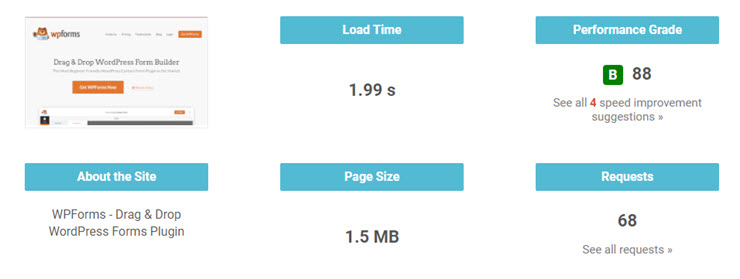
The tool is being tested in multiple locations around the world. This is important because your website may load quickly for you if you are geographically close to your server, but slow for visitors in other countries.
☐ Alternative: Use Google PageSpeed Insights (free)
You can also use it to check desktop and mobile performance PageSpeed.Web.Devthe official speed tool from Google. Here too, all you have to do is enter the URL of your website.
PageSpeed Insights shows you exactly what Google sees when ranking your website. It gives you a score from 0 to 100 and shows you specific problems that need to be fixed.
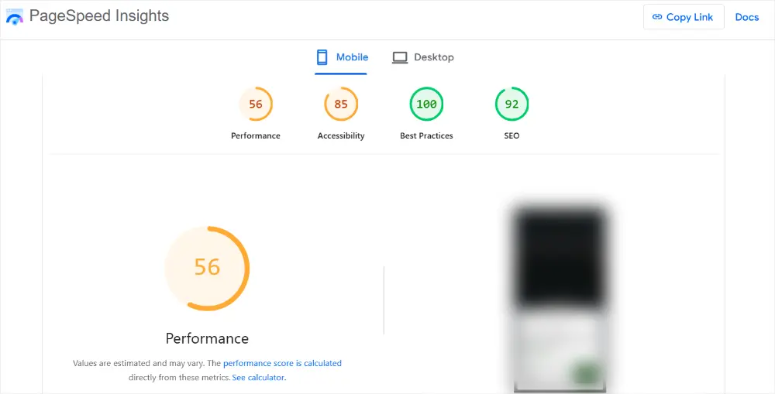
Don’t panic if your score is low. Most WordPress sites start between 30 and 60 points before optimization. After following this checklist you should see values above 85.
☐ Write down your current score
Take a screenshot or write down these numbers:
- Loading time (in seconds)
- PageSpeed score (mobile and desktop)
- Core Web Vitals status (if displayed)
It’s important to document this because in 35 minutes you’ll want to celebrate your progress.
What causes WordPress sites to be slow?
Understanding why WordPress sites become slow can help you avoid future problems. Here are the main culprits:
☐ Cheap shared hosting with overloaded servers
Your web host is like the foundation of a house. So if the foundation is weak, nothing else matters.
Cheap hosting companies ($1-3/month) can be great for small websites, but they often overload their servers, resulting in slower performance.
Imagine 500 websites trying to use the same computer at the same time. Everything is slowing down.
Good hosting providers invest in fast SSD drives, lots of RAM and fewer sites per server. It costs more, but the difference in speed is dramatic.
☐ Bloated themes full of unnecessary features
Many WordPress themes try to be everything for everyone. These include page builders, sliders, contact forms, social media widgets, and dozens of other features you’ll never use.
It’s like buying a Swiss Army knife when all you need is a screwdriver.
☐ Huge, unoptimized images slow down every page
This is the most common beginner mistake. You take a photo with your phone, which can be around 8MB, and upload it directly to WordPress. However, most website images only need to be 100-300KB.
☐ Too many plugins or poorly coded ones
Each plugin adds additional code that your website needs to load. It’s like carrying 20 backpacks instead of just one – you move much slower.
Many beginners install plugins for every feature they want. Before you know it, you’ll have more than 50 plugins running at the same time.
The worst? Like bloated themes, some plugins load their code on every page, even where it is not needed.
A contact form plugin may load its CSS and JavaScript into your blog posts that don’t have a contact form.
☐ Outdated PHP versions (everything before 8.0)
PHP is the programming language that powers WordPress. It’s like the engine in your car – newer engines run much more efficiently.
Now PHP 8.3 runs about 50% faster than PHP 7.4. If you’re still using PHP 5.6 or older, you’re missing out on massive speed improvements.
However, many hosting companies default to older versions of PHP because they are more “stable”. But stable doesn’t mean fast. It’s like choosing a horse over a car because horses are “more reliable.”
The good news? Upgrading PHP usually requires one click in your hosting control panel. Also, most modern WordPress themes and plugins work perfectly with PHP 8.0+.
☐ No caching setup at all
Without caching, your website creates every page from scratch for every visitor.
Imagine a restaurant where the chef throws away all the ingredients after each order and has to restock the entire kitchen before he can prepare the next meal.
WordPress generates pages dynamically by pulling data from your database, processing PHP code, and putting it all together. This process takes time.
Here’s what happens without caching:
- Visitor requests your homepage
- WordPress queries the database for posts
- PHP processes all the code
- WordPress compiles the final HTML code
- Page loads (2-8 seconds later)
With caching, the same process occurs once. WordPress then saves the finished page and makes it immediately available to future visitors.
☐ Flooding of the database with years of accumulated garbage data
Your WordPress database is like a filing cabinet. Over time, it fills up with junk that you no longer need.
This garbage includes:
- Spam comments (sometimes thousands of them)
- Old post revisions (WordPress saves every draft)
- Expired temporary data
- Settings of deleted plugins
- Orphaned metadata with no purpose
A clean database can be 10-50% smaller and respond to queries much faster. The difference becomes dramatic on high-traffic, content-heavy websites.
As you may have seen, I’ve only discussed the basics. Here you will find additional resources to help you better understand WordPress.
Now that you understand what makes WordPress sites slow, let’s start fixing these problems one by one. The next section covers the basic fixes that will give you the biggest speed improvements.
Foundation Fixes (10 minutes)
These are the high-impact changes that will set you on the path to success. Think of it like repairing your foundation before decorating the house.
The basic fixes may seem simple, but that’s where you’ll see the most dramatic improvements. They will also help you fix the main problems slowing down your website discussed above.
☐ Choose better hosting (if necessary)
Now hosting is a sensitive area that you really need to pay close attention to.
While many cheap hosting services can result in slower performance, you may be surprised by some cheap services that outperform premium services.
So before you make the switch, be sure to read my hosting comparison article for more details.
Now, if you notice any problems with your hosting or your WordPress admin dashboard takes more than 5 seconds to load, then in this case I recommend you to upgrade.
Here are some excellent hosting platforms that I suggest.
Budget Option: Hostinger ($2.99/month)
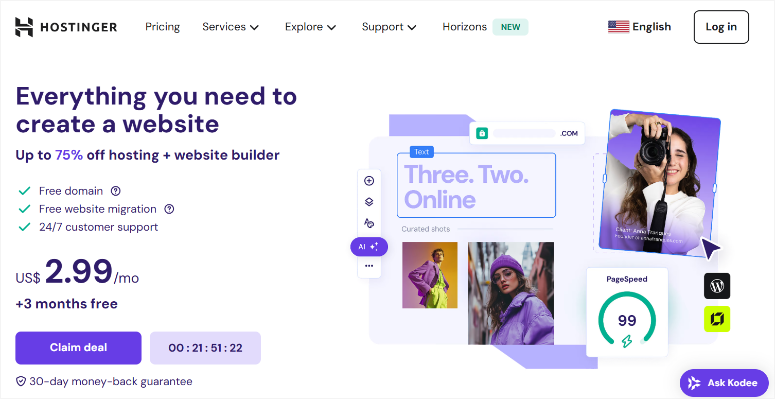
Hostinger offers great value for money for beginners who want performance without breaking the bank.
They use modern LiteSpeed servers instead of the older Apache technology, which handles traffic spikes much better and has built-in caching.
Additionally, Hostinger has WordPress-specific tools that automatically optimize your site during installation, giving you speed benefits right from the start.
- Includes free SSL certificate and LiteSpeed caching
- Built-in WordPress optimization tools
- Good for personal blogs and small business sites
- Excellent average load time
For more information, see my Hostinger review.
Recommended: Bluehost ($1.99/month with IsItWP coupon)

Bluehost is perfect for WordPress beginners because its dashboard is designed for people who have never managed a website before.
If you call support, they will understand the WordPress-specific issues and can help you optimize for speed.
Additionally, their servers are specifically optimized for WordPress, meaning better performance compared to generic hosting.
- WordPress.org officially recommends them
- One-click WordPress installation with optimization
- 24/7 support specifically for WordPress beginners
- Great average load time
Check out my latest Bluehost review here. Additionally, here is a comparison article on Bluehost and Hostinger, two of my favorites in this post, to see how they compare to each other.
You can also check our Bluehost coupon page for the best deals to get you started.
Best Performance: SiteGround ($3.99/month)
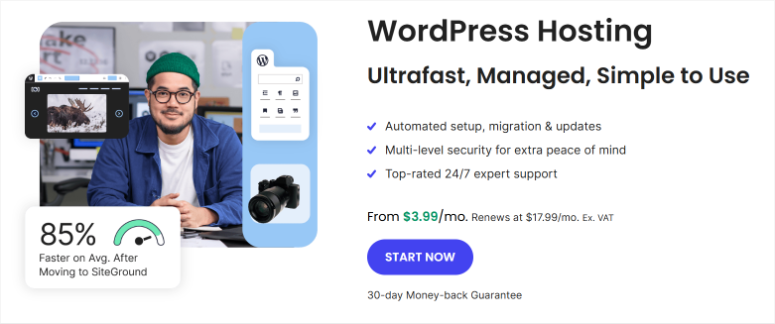
SiteGround offers the fastest performance because it uses Google Cloud servers – the same infrastructure that powers Google Search.
Their SuperCacher technology works better than most caching plugins and they automatically optimize your WordPress installation for maximum speed.
If performance is your top priority, this is your best choice.
- The fastest loading times in my tests
- Integrated SuperCacher technology
- Google Cloud infrastructure
- Best for growing businesses or anyone who values speed
Check out my updated SiteGround review here.
You can also check our SiteGround coupon page for the best deals to get you started.
Now if you’re looking for more great hosting options, I have a few articles you can check out.
☐ Choose a quick topic
Your theme is like the outfit of your website. Some outfits are heavy winter coats with lots of pockets and zippers. Others are lightweight t-shirts.
Most WordPress users choose themes based on how they look in demos. But these beautiful demos often hide serious speed problems.
To help you with this problem, here are my top theme picks based on their performance. I also selected themes that offer a free version so you can test their performance first before making a decision.
aThemes Sydney – Fast and beginner-friendly
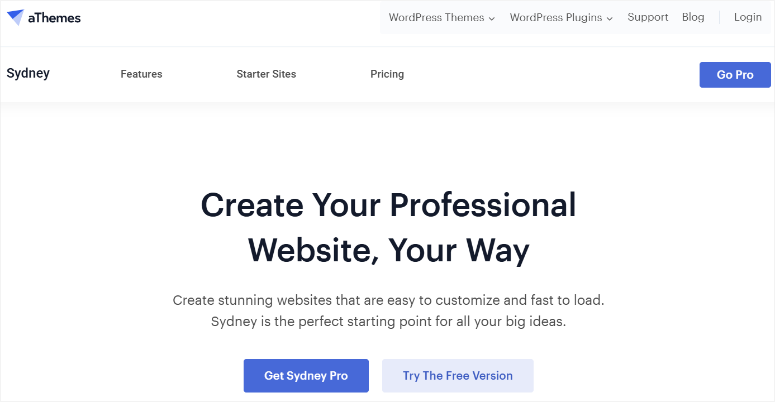
Sydney combines professional design with impressive speed optimization, making it perfect for corporate websites that need to look good and load quickly.
Thanks to the built-in optimization features, you don’t need additional plugins to achieve excellent performance.
- Beautiful business theme with a high PageSpeed score
- Only uses vanilla JavaScript, no jQuery
- Built-in lazy loading and minimized code
- Over 100,000 active installations
Free theme? Yes
Prices: Starts at $63 per year.
Check out my Sydney review here.
Seed Prod – Drag and drop theme builder

Seed Prod provides the visual control of page builders without the typical speed penalties.
If you need to create custom layouts but don’t want to sacrifice performance, this is the best option for drag-and-drop functionality.
- Drag and drop page builder with theme functionality
- Ideal for landing pages and custom layouts
- Minimal performance impact compared to other builders
- Perfect if you want visual design control
Free theme? Yes
Prices: Starts at $39.50 per year.
Check out my detailed SeedProd review here.
Astra – quick and easy to customize

Astra is perfect for beginners because it is modular, meaning you only load the functions you actually use.
Do you want a slider? Enable the Slider module. Don’t you need it? It won’t slow down your website. This smart approach ensures your website stays fast even as you add features over time.
- Small page size with few HTTP requests
- Works with any page builder
- Over 1 million active installs
Free theme? Yes
Prices: Starts at $69 per year.
Check out my Astra theme review here.
Are these topic recommendations not for you? Here are more topics for you to check out.
Changing the subject is straightforward, but requires caution.
I always We recommend that you first create a full backup of your website. You can use Duplicator or any other top backup plugin you have.
Apart from that, many hosts also offer backup options if you don’t want to use a plugin.
When you’re done, go to Appearance » Themesclick “Add New”. When installing a free theme, search for your chosen theme. For pro themes you need to upload them from your PC Upload Button.
Then install it and activate it.
If something is wrong after activation, just return to Appearance » Themes and reactivate your previous theme or restore from your backup if necessary.
Pro tip: Most theme changes are seamless, but if you have custom CSS or a specific style, you may need to recreate them with your new theme.
If you run into any problems, check out my post on installing a WordPress theme.
☐ Update everything
Every WordPress update includes performance improvements.
Old WordPress software is like driving with the parking brake on. Updates eliminate bugs that slow down work and close security holes that could lead to your website being hacked.
Let me explain it in detail.
- Update all plugins for performance improvements: Old plugins slow down your website because they have errors and problems that accumulate over time.
- When you update plugins, you fix these speed issues and often make your website 20-30% faster.
- Don’t skip updates for fear of breaking something – old plugins actually cause more problems than new ones.
- Update your theme for compatibility: Theme updates fix issues and make your website work better with the latest WordPress features.
- Enable automatic updates: Automatic updates keep your website fast and secure without you having to think about it.
- WordPress notifies you via email when updates are made, so you always know what has changed. These automatic updates are safe and only install changes that have been thoroughly tested.
If you encounter any problems, you can also use one of these auto-update plugins to help you.
What happens if something breaks after the update?
Most good hosting providers perform automatic backups. If something goes wrong, contact your host’s support team. You can restore your website from a backup in minutes.
This foundation work takes 10 minutes but will give you the biggest speed improvements without any heavy technical lifting.
Let’s now move on to further technical optimization options. The next section is about the caching setup, which is often the biggest speed boost you can get.
Instant Speed Boosters (10 Minutes)
As mentioned earlier, without caching, WordPress has to rebuild the page every time someone visits your website.
It does this by querying your database, processing PHP code, and putting it all together. With caching, WordPress saves a finished copy of your site and serves it immediately.
The result? Your website can go from 8 seconds to 3 seconds simply by setting up caching correctly.
☐ Choose a reliable caching plugin
Caching plugins reduce the load on your server by storing pre-built copies of your pages, so your hosting doesn’t have to work as hard each time you visit.
This means your website can handle more visitors without slowing down and uses fewer hosting resources. These plugins create fast-loading copies of your pages that visitors see immediately.
Here are my top cache plugin options to improve WordPress performance.
WP Super Cache – Best free option
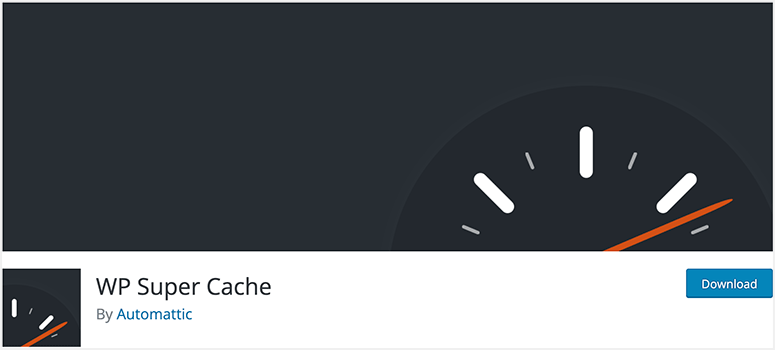
WP Super Cache is completely free with simple page caching that works out of the box. It creates static HTML copies of your pages and includes GZIP compression to make files smaller.
Perfect for beginners as it’s straightforward – install, turn it on and your website will speed up in just two clicks.
For more information, see my WP Super Cache review.
WP Rocket (Recommended) – Best Premium Cache Option ($59/year)
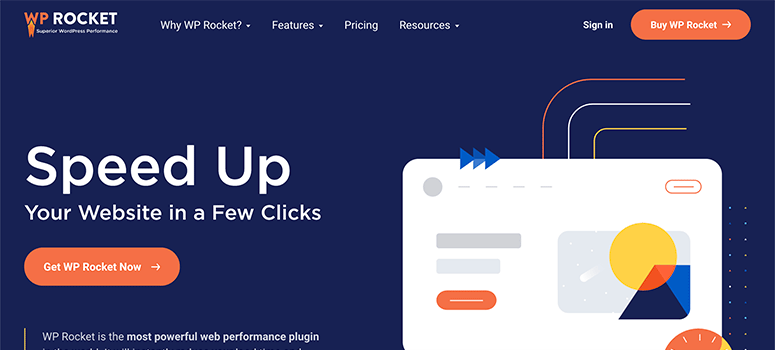
WP Rocket offers one-click optimization that combines caching, file compression, lazy loading and database cleaning in one plugin.
Instead of installing multiple plugins, WP Rocket does everything automatically with smart default settings that work for 95% of websites.
This caching plugin is worth every penny as it eliminates the need for technical knowledge while providing professional-level optimization.
Check out my full WP Rocket review here.
W3 total cache – Alternative free option
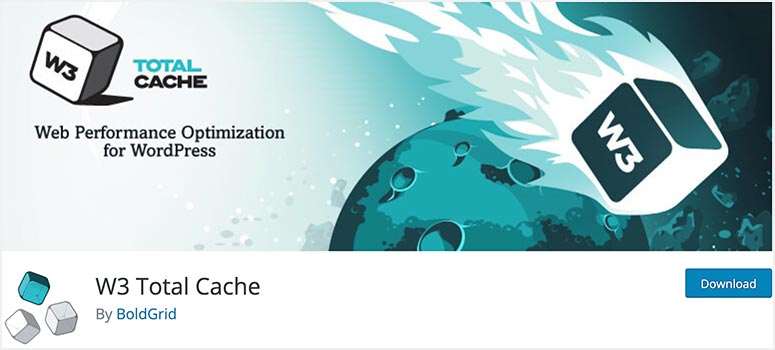
W3 total cache features advanced caching with built-in object caching, database optimization, and CDN integration.
It offers maximum customization and control but requires more technical knowledge to configure properly.
W3 Total Cache is best suited for users who are comfortable with settings and want granular control over their caching setup.
Quick test: Visit your website and notice how much faster pages load. Then try visiting different pages – they should all load quickly now.
Note: Only install one caching plugin at a time. Keep in mind that using multiple caching plugins can conflict with each other and actually slow down your website or break it completely.
However, you can easily combine any caching plugin with Cloudflare as this free CDN works on a different level.
It works before requests even reach your server, while your WordPress caching plugin works on your actual website files.
That brings us to the next item on our checklist: setting up Cloudflare.
☐ Set up a free CDN with Cloudflare
A CDN (Content Delivery Network) allows you to store copies of your website worldwide.
Let me explain how Cloud flare functions.

This free CDN acts as an intermediary between your website and visitors, storing copies of your website on servers around the world.
When someone visits your website, they get the content from the nearest server rather than your hosting server, making everything load much faster.
So when someone in Australia visits your website, they will receive it from a server in Australia or a server near them, rather than your main server in the US.
The free plan is often enough for most WordPress sites.
It includes automatic file compression, image optimization, and code minification that occurs without your intervention.
Cloudflare also blocks malicious traffic before it reaches your server, reducing the load on your hosting. Their global network spans 200 cities, giving visitors fast load times from anywhere.
What results can you expect after setting? up Cloudflare?
Your website should load 20-40% faster for visitors around the world, with international visitors seeing the biggest improvements.
You’ll also get basic security protection and detailed analytics on your website’s performance.
Check out this post for a complete breakdown on how to set up Cloudflare.
Cloudflare isn’t the only CDN on the market. If you’re looking for more options, check out my list of the best WordPress CDNs.
Additionally, you can also compare Sucuri vs. SiteLock vs. CloudFlare to find out which one is best for you.
☐ Enable GZIP compression
GZIP compression is like vacuum sealing your website files, shrinking everything without losing quality.
It compresses your HTML, CSS and JavaScript files before sending them to visitors’ browsers and then decompresses them immediately.
The good thing is that most caching plugins and modern hosting providers enable GZIP automatically. So, you can use any of the caching plugins discussed above.
After you set up caching and CDN, your website should feel significantly faster. Most websites see a significant improvement in loading times with these three optimizations alone.
The next section is about image optimization, which is often the second largest speed killer after poor caching.
Image optimization (5 minutes)
As a WordPress expert with 10 years of experience, I can tell you that most WordPress sites are slow because of images and not because of code or hosting issues.
When you upload a photo to WordPress directly from your phone, you often add files that are 5 to 8 MB in size to your pages. This is like forcing every visitor to download a small movie just to see one image.
But here’s the good news: you can reduce the size of image files by 70-90% without any visible loss of quality. Your photos will look the same, but will load much faster.
☐ Use an image optimization plugin
Image optimization plugins automatically shrink your photos without compromising quality.
They work by removing extra data from image files and using intelligent compression that ensures images look good while ensuring they load much faster on your website.
Here are some image compression tools I use.
Smush (Free):
Smush automatically resizes images by 40-60% and includes lazy loading so they only load when people scroll to them.
It works with any images you’ve already uploaded, with a limit of 1MB per image in the free version. Ideal for beginners as it works by itself once installed.
ShortPixel (recommended):
Starting at $9.99 per month, ShortPixel reduces images by 70-90% while still looking great. It automatically converts your images to WebP format, making files 25% smaller than regular JPEG photos.
There are no size limits and it can optimize all your existing images at once.
TinyPNG (Budget):
This is a professional quality compression plugin that major websites around the world use. TinyPNG is perfect if you don’t upload a lot of new images every month as you get 100 free compressions.
This is still enough for most websites.
Why modern image formats are important
WebP and AVIF are newer image types that are much smaller than old JPEG and PNG files. In fact, they are sometimes 50% smaller for the same quality.
Most modern browsers can display these formats and the plugins automatically display the correct format to each visitor’s browser.
This means faster loading for most users while maintaining compatibility with older browsers.
So before you decide, keep in mind that ShortPixel includes WebP conversion automatically, while Smush and TinyPNG focus on traditional compression.
☐ Set up lazy loading
Lazy loading means that images are only downloaded when visitors scroll down to view them, rather than loading all images when the page is first opened.
This saves bandwidth and makes your website load much faster, especially on mobile devices.
If someone only reads the first paragraph of your blog post, they won’t waste time downloading images at the bottom of the page.
WordPress has had lazy loading built in since version 5.5, so your images will already load this way if you’re using a recent version.
While WordPress’s built-in lazy loading works well for simple images, dedicated plugins offer advanced functionality and better performance optimization.
With that in mind, you can use WP Rocket, which offers advanced lazy loading for videos and iframes with smart exclusions for above-the-fold images.
Over and beyond Smush offers integrated lazy loading with its image optimization. While a3 Lazy Load Offers lightweight lazy loading with YouTube video support and custom loading effects.
Test your lazy loading:
Open a long page on your website and scroll slowly. You should see the images loading just before they appear. If images load late and layout shifts occur, adjust the offset settings in your plugin.
For more options, check out my post on the best lazy loading plugins for WordPress.
☐ Optimize images when uploading
It’s better to prevent image bloat than to fix it later.
WordPress can automatically resize large images when you upload them, creating smaller versions for different uses on your site.
This prevents huge 5MB photos from slowing down your pages when you only need a 300px thumbnail.
However, to avoid overloading your WordPress site, you should choose the right image format for each use.
- JPEG for photos
- PNG for graphics with transparency
- SVG for simple icons that need to be scaled perfectly
Also remember to set up automatic optimization. This saves you from having to manually correct images later.
You can configure automatic resizing Settings » Media with maximum sizes like 1920×1920 for large images.
Additionally, there are several tools that can make this process even more efficient.
For example, TinyJPG Allows you to compress images before uploading. Photoshop’s Save for Web feature significantly reduces file size.
However, most image optimization plugins also take care of compression automatically when uploading.
The next section covers database cleanup and plugin management – the final pieces of the speed puzzle.
Database and plugin cleanup (3 minutes)
Your WordPress database often contains old comments, post revisions, and leftover plugin data that piles up and slows down every database query.
How do you fix the problem?
☐ Remove unused plugins and themes
Every plugin you install adds code to your website, even if it is disabled. It’s like keeping old apps on your phone – they take up storage space and sometimes run in the background.
Find unused plugins:
Go to Plugins » Installed plugins in your WordPress dashboard. Look at the list and honestly ask yourself, “Am I actually using this?”
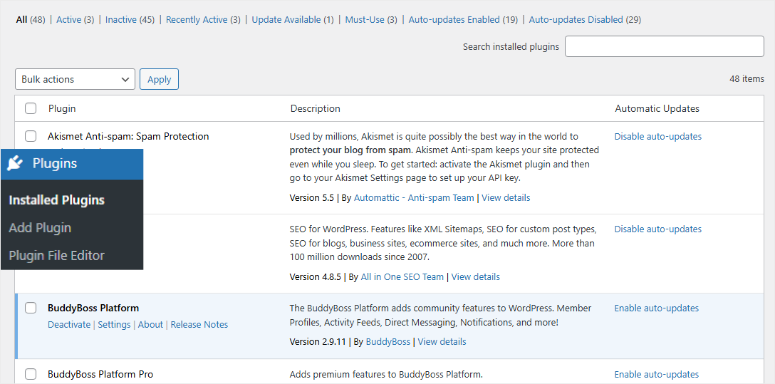
Common plugins that beginners install but rarely use:
- Multiple contact form plugins (you only need one)
- SEO plugins that you installed but never configured
- Backup plugins that you have replaced with hosting backups
- Social media plugins that you set up once and then forgot about
Don’t just deactivate unused plugins, delete them:
If you find a plugin that you don’t use, click “Delete” instead of just “Deactivate.” Disabled plugins continue to take up storage space and can create security holes.
WordPress will ask you to confirm the deletion as the plugin files will be permanently removed. Click Yes, delete these files if you are sure you don’t need them.
Important: Don’t delete plugins that you are actively using, even if you are not sure what they do. When in doubt, ask yourself: “Did my website work properly before installation?” If so, you probably don’t need it.
What about inactive themes?
Go to Appearance » Themes and delete any themes you don’t use. WordPress requires at least one theme, so keep your active theme and perhaps a backup.
Expected results: Your website will load faster, use fewer server resources, and have fewer potential security vulnerabilities.
☐ Clean up your database
Your WordPress database stores everything and over time it becomes cluttered with unnecessary information that slows down the loading of each page.
This cleanup will make database queries run 20-30% faster and significantly reduce the size of your hosting backups.
You can clean the database manually via phpMyAdmin in your hosting control panel by optimizing tables and removing specific entries.
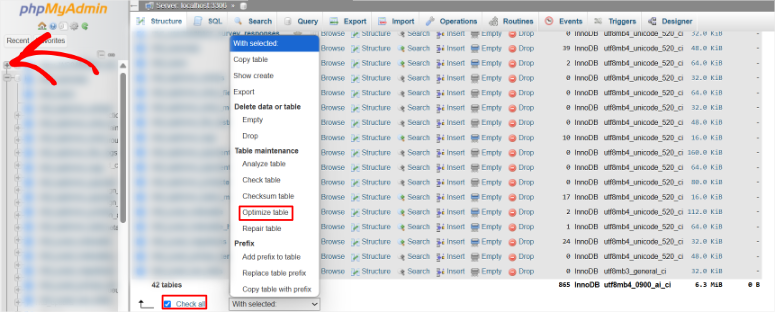
However, this can be difficult for beginners. Instead, you can use data cleansing plugins to carry out this cleansing process safely for you, eliminating the guesswork and risk of deleting important data.
First of all, you can use the free version of WP-Optimize to safely remove spam comments, post revisions, and expired temporary data. I like this plugin because it shows you exactly what will be deleted first.
Otherwise, Advanced database cleaner processes orphaned metadata from deleted plugins. WP Sweep Provides easy database maintenance with preview capability before cleanup.
To help you with this process, here are the best WordPress database tools to clean and optimize your website.
You can also follow this step-by-step guide to remove unused files from your WordPress media library. Then follow this tutorial to clean your WordPress database.
☐ Limit post revisions
WordPress saves each draft as you write, creating multiple versions that clog your database and slow down queries.
With each revision, WordPress becomes more difficult to find your current content. Limit revisions to 3-5 by adding define('WP_POST_REVISIONS', 3); to yours wp-config.php File.
You can also use that WPCode plugin to safely add this code without editing files directly.
All you need to do is install WPCode, create a new snippet, paste the revision limit code and activate it from your WordPress dashboard.
Check out this post to find the snippet to limit the number of revisions and use it with WPCode. You can also follow this WPCode review to see how to use it.
Clean up existing revisions:
Now the above steps will only help you limit post revisions for future content. But what about posts that are already online?
To do this, use WP-Optimize to remove excess existing revisions. Here too, the setup is very easy. Simply select “Keep Latest 3 Revisions” to keep some backup versions while removing the excess versions.
Expected results: Your database will become significantly smaller and reload times will improve, especially for content-intensive websites.
Comments can cause database bloat, especially if you receive spam or do not actively moderate it.
For websites with few comments:
Go to Settings » Discussion and configure these settings:
- Disable “Allow people to comment on new posts”
- This will stop any new comment spam immediately
- Existing comments remain visible
For sites wanting comments:
Leave comments enabled, but add these protections:
- Check “Comment author must provide name and email address”
- Check “Users must be registered and logged in to comment”
- Check “Comment must be approved manually”
Clean up existing comment spam:
In WP-Optimize, enable “Clean all spam comments” and “Clean all comments deleted in the trash”. This will immediately remove the obvious junk.
You can also use an anti-spam plugin like Akismet, which is free for personal websites, to automatically filter future spam comments.
Comment pagination for popular posts:
If you have posts with more than 50 comments, enable comment pagination:
- Go to Settings » Discussion
- Enable “Split comments into pages”
- Set to 10-15 comments per page
This prevents long comment threads from slowing down the page load.
This cleanup section only takes 3 minutes, but often provides dramatic speed improvements. Websites with years of accumulated junk sometimes experience 40-50% faster loading times after a thorough cleanup.
Side note: Many WordPress experts recommend turning off comments completely. But that’s often not the best move. Comments help users engage with your site and stay on it longer, making them important for search engine optimization (SEO).
Instead, I suggest using one of these WordPress comment plugins to improve engagement with your visitors and get the most value out of it.
The next section is about advanced optimizations that get even more performance with minimal effort.
Advanced Quick Wins (7 minutes)
These optimizations may sound technical, but they are actually easy to implement. Think of them as the finishing touches that turn a good website into a great one.
Each of these optimizations only takes 1-2 minutes, but can shave precious milliseconds off your load time. When combined, they often take websites from “good” performance to “excellent” performance.
☐ Optimize fonts
Google fonts are nice, but they slow down your website because each custom font requires an additional trip to Google’s servers, adding 200-500ms to your load time.
Keep in mind that any external font request will introduce a delay that will impact your Core Web Vitals results and user experience.
This becomes a particular problem on mobile devices and slower internet connections, where every millisecond counts in keeping visitors engaged.
You can perform manual optimization by limiting font families to one or two in your theme customizer.
You can do this by using and adding only the necessary font weights in your Google Fonts selection font-display:swap in your theme’s CSS file to prevent invisible text.
Alternatively you can use OMGF (Optimize my Google Fonts)This solves this problem by downloading Google Fonts to your own server, eliminating external requests and improving GDPR compliance.
☐ Enable lazy loading for videos
Uploading videos from YouTube, Vimeo or even embedding them can cause massive loading delays. A single YouTube embed adds about 500KB of JavaScript, even if visitors never click play.
As a result, multiple videos easily increase loading time by 2-3 seconds, negatively impacting your Core Web Vitals scores.
You can manually reduce the impact of videos by limiting embeds per page and using video thumbnails with custom play buttons.
Otherwise, Lazy Load by WP Rocket, A free plugin can replace video embeds with clickable thumbnails that only load the actual video when clicked.
Now, if you want better visual appeal and want your videos to update automatically, use feeds.
Smash Balloon lets you create video feeds that don’t bloat your code, are faster, and don’t use up your hosting storage or bandwidth.
Additionally, you can add video feeds from multiple platforms to create a social board that will keep your users engaged and boost your website performance.

In this article, you will learn how to add YouTube feeds to WordPress. Then check out my Smash Balloon review to see all the types of bloat-free feeds you can create.
☐ Reduce external HTTP requests
Each external resource, such as Google Analytics, social media widgets, and chat tools, creates additional requests that slow down the loading process by 100-500 ms each.
Removing 5-10 external requests can save 1-2 seconds of loading time.
Open your website and press F12 to open developer tools. Then go to the “Network” tab and reload your page. Look for requests to external domains, not your own website.
Common external requests that slow down websites:
- Google Analytics
- Google Fonts (fixed above with OMGF)
- Social media embed scripts
- Chat widgets
- Advertising networks
- External CDNs for unused resources
Minimize external requests:
- Google Analytics: Use Google Analytics 4 (GA4) instead of older versions. It’s faster and more efficient.
- Social media: Replace social media widgets with simple links. Social sharing buttons often load more than 500KB of JavaScript that you don’t need.
- Chat widgets: Only load chat widgets on pages where they are actually useful (contact page, support pages). Remove them from blog posts and other content pages.
- Remove unused tracking codes: Check your theme header for old tracking codes from tools you no longer use.
- Expected results: Each external request you eliminate saves 100-500ms load time. Removing 5-10 external requests can reduce your load time by 1-2 seconds.
Posts with lots of comments can add 2-3 seconds to loading time because WordPress loads all comments at once.
Comment pagination breaks long comment threads into manageable chunks of 10 to 15 comments per page, allowing posts with hundreds of comments to load 30 to 60% faster.
To add comment pagination, go to Settings » Discussionand enable “Split comments into pages.”
☐ Use excerpts instead of full posts
When you display full blog posts on your homepage, visitors have to download massive amounts of content – sometimes 2-3MB just to see your blog overview.
Excerpts instead show short summaries, making homepages load three to five times faster while allowing visitors to still click to read full posts.
Go to excerpts in Settings » Reading by selecting “Excerpt” instead of “Full Text”.
☐ Enable browser caching
Browser caching tells visitors’ browsers to remember your files so that when they visit again, they will be loaded immediately instead of downloading them again.
This significantly speeds up repeat visits and reduces server load. Set the cache expiration for images and CSS files to 1 month via your .htaccess file or your hosting settings.
In addition, WP Rocket and Cloud flare Automatically configure optimal browser caching settings.
Test browser caching:
Visit your website and then immediately reload the page. The second load should load most of the images and files from the cache (this will show up in the Network tab of the developer tools).
Expected results: Returning visitors experience 50-80% faster load times because their browsers don’t have to re-download static files.
After implementing these advanced optimizations, your website should consistently load in under 3 seconds. These seemingly small optimizations often provide the final step from “good” to “excellent” performance.
In the next section, you’ll learn how to test your improvements and celebrate your success.
Celebrate your speed improvements
☐ Test your result
After implementing these optimizations, test your site’s new speed using the same tools from the start.
Most websites see dramatic improvements. Loading times drop from 8+ seconds to under 3 seconds and page speeds increase from 40-50 to 85-90+.
Also, don’t forget to test on mobile devices with cellular data to experience real-world performance improvements. Then document your before/after results for future reference.
☐ Review the business impact
Speed improvements should lead to better business results within a few weeks.
Track these key metrics in Google Analytics and Google Search Console to see how your faster website impacts your real business goals.
- Bounce rate (Google Analytics): Should decrease as more visitors stay on your faster loading pages. Faster websites typically experience a 10-30% lower bounce rate within the first month.
- Session duration: Visitors should spend more time exploring your website as pages load quickly. Faster loading encourages people to view more pages and engage more deeply with your content.
- Conversion rates: Newsletter registrations, contact form submissions or sales should increase measurably. Even small speed improvements often increase conversions by 10-20% as friction decreases.
- Search rankings: Monitor your keyword rankings over the next month to see incremental improvements. Faster websites often see a ranking boost because Google rewards better Core Web Vitals results.
- Mobile data traffic: Mobile visitors should be more engaged with your optimized mobile experience. Check mobile-specific metrics in Google Analytics for increased page views and lower bounce rates.
To make monitoring these metrics easier, I recommend you use MonsterInsightsthe best Google Analytics plugin. It simplifies these metrics so you can easily understand them.
Plus, you can use it directly in your WordPress dashboard, so you don’t have to switch browser tabs.
You can also use traffic tracking tools to perform even more in-depth website analysis.
Common Mistakes to Avoid When Tuning Performance (Quick Checklist)
Avoid these common mistakes that can actually slow down your WordPress site or hinder functionality during optimization.
This quick checklist will help you avoid pitfalls that beginners often encounter when trying to speed up their websites.
- ☐ Do not install multiple caching plugins: This is the #1 mistake beginners make. Use WP Rocket OR WP Super Cache, never both. Multiple caching plugins conflict and actually slow down your website.
- ☐ Don’t ignore the plugin update warnings: Outdated plugins often have memory leaks and compatibility issues that get worse over time. This “harmless” old plugin may be secretly consuming server resources.
- ☐ Do not upload images directly from your camera: Always resize photos before uploading. Your phone’s 24-megapixel camera creates files much larger than required for web use.
- ☐ Don’t install plugins “just to try them out”: Every plugin you install leaves a trace in your database, even after deletion. Only install plugins that you actually want to use.
- ☐ Do not change the theme frequently: Changing themes can leave orphaned data and affect optimization settings. Choose a quick topic and stick to it.
Well done! At this point, you should see significant improvements in your website speed and performance. And just like that, you will have completed the entire optimization process in less than 35 minutes.
If something is unclear, check out the frequently asked questions below.
FAQs: WordPress Speed and Performance Optimization Checklist
Do I need to know coding to follow this website performance checklist?
No programming knowledge required! Everything in this checklist uses point-and-click interfaces or simple copy-paste instructions.
The most “technical” thing you could do is add a line to wp-config.php to restrict post revisions, and we’ll provide the exact code to use. Most hosting providers will even do this for you if you ask support.
All the plugins mentioned have user-friendly dashboards designed for beginners. WP Rocket, for example, works perfectly with the default settings – just install and activate.
What happens if my website breaks during optimization?
This is the biggest fear for beginners, but it can be easily prevented. Before making any changes, create a full backup via your hosting control panel or a reliable backup plugin. Most good hosting providers and plugins offer one-click backup restore.
If something breaks, first clear all caches (fixes 80% of problems) and then disable the last installed plugin. Contact your hosting support – they can restore from backup in minutes.
How often should I run this optimization checklist?
Complete one-off checklist when you first set up your website. Monthly maintenance takes 5 minutes for updates and database cleanup. Quarterly checkup takes 15 minutes for more in-depth maintenance. Annual assessment to review hosting upgrades or tool changes.
The initial optimization is the biggest time investment. After that, maintaining speed is much easier than achieving it.
Can I perform this optimization on a live website?
Yes, but follow safety guidelines. Safe on live sites: Install caching plugins, image optimization, database cleanup, WordPress and plugin updates, and set up Cloudflare CDN.
Best during off-peak times: major theme changes, PHP version upgrades, extensive plugin testing. Always make a backup first.
Will speed optimization affect my SEO rankings?
Yes, positive! Google has been using page speed as a ranking factor since 2010 and became even more important in 2021 with the Core Web Vitals.
Typical SEO improvements include higher Core Web Vitals scores, better mobile search rankings, improved user experience signals, and lower bounce rates. Technical improvements occur immediately, ranking improvements take 2-8 weeks, and traffic increases occur within 1-3 months.
What is the difference between free and premium optimization tools?
Free tools offer basic caching and optimization, 40-60% speed improvements, manual configuration required, and community support only.
Premium tools offer advanced automation features, 60-90% speed improvements, one-click optimization, and priority support. Start with free tools and upgrade to premium as your website generates revenue.
How do I know if my hosting is the problem?
The most obvious sign is that even after optimization, your website loads slowly, experiences frequent downtime or error messages, the WordPress admin dashboard takes more than 5 seconds to load, and the hosting cost is less than $3 per month.
If your website loads quickly from your location but slowly from other countries, it’s usually a hosting infrastructure issue and not an optimization issue.
What should I do if my PageSpeed score is still low after optimization?
Scores above 85 are excellent – focus on maintaining performance. Then values between 70 and 84 are good – minor changes might help, but don’t worry. Values below 70 mean you should check the checklist for missed optimizations.
Remember that real loading speed is more important than perfect results. A website that loads in 2-3 seconds and has a score of 75 is better than a website that has a score of 95 but loads in 4 seconds.
What if my website is still slow after I follow everything?
Try systematic troubleshooting. Temporarily test with a different theme, disable all plugins except caching, contact your hosting provider regarding server performance, and consider professional optimization advice.
Can I optimize an existing website with a lot of content?
Absolutely! Content-heavy websites often see the biggest improvements because they offer more opportunities for optimization.
Special Considerations: Image optimization may take longer (runs overnight), database cleanup may cause significant bloat. Consider premium bulk optimization tools and back up everything before you begin. Typical results: Speed improvements of 50-80% are common for large websites.
Final Verdict: Should I Optimize My WordPress Site?
Absolutely yes! WordPress optimization is one of the most valuable investments you can make for your website.
The benefits far outweigh the minimal time and cost involved, providing immediate and long-term returns that compound over time.
Additionally, your website speed directly impacts everything that matters, from search rankings to user experience, conversions, and mobile performance.
The best part is that you can optimize your website by simply investing time, or less than $100/year if you choose premium options.
Unlike paid advertising, which stops when you stop paying, speed improvements work 24/7 to grow your business.
The end result is that every WordPress site should be optimized for speed.
The question is not whether you should optimize, but how quickly you can start optimizing. Your visitors, search rankings, and bottom line will thank you.
Check out this article for a complete overview of how to increase the performance of your WordPress site if you need to clarify anything from this checklist.
Additionally, here are other resources you may want to read.
Now that your WordPress site is optimized for lightning-fast performance, these additional resources will help you maintain and improve your site’s overall functionality and user experience.
With this detailed WordPress speed and performance checklist, you can focus on growing your business instead of worrying about slow loading times.
These speed improvements will continue to deliver better user experiences, higher search rankings, and higher conversions for years to come.

